定语从句、被动语态
- 格式:pdf
- 大小:130.23 KB
- 文档页数:4
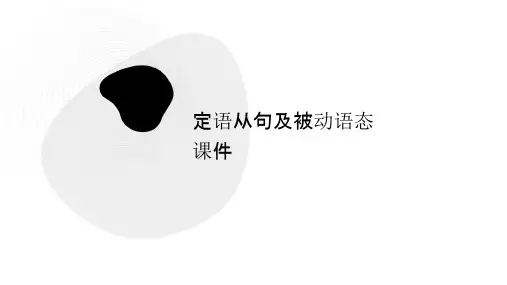
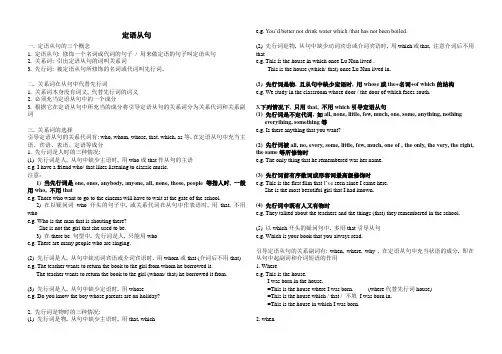
定语从句一. 定语从句的三个概念1. 定语从句: 修饰一个名词或代词的句子/ 用来做定语的句子叫定语从句2. 关系词: 引出定语从句的词叫关系词3. 先行词: 被定语从句所修饰的名词或代词叫先行词。
二. 关系词在从句中代替先行词1. 关系词本身没有词义, 代替先行词的词义2. 必须充当定语从句中的一个成分3. 根据它在定语从句中所充当的成分将引导定语从句的关系词分为关系代词和关系副词三. 关系词的选择引导定语从句的关系代词有: who, whom, whose, that, which, as等,在定语从句中充当主语、宾语、表语、定语等成分1. 先行词是人时的三种情况:(1) 先行词是人, 从句中缺少主语时, 用who或that作从句的主语e.g. I have a friend who/ that likes listening to classic music.注意:1) 当先行词是one, ones, anybody, anyone, all, none, those, people 等指人时, 一般用who, 不用thate.g. Those who want to go to the cinema will have to wait at the gate of the school.2) 在以疑问词who开头的句子中, 或关系代词在从句中作表语时, 用that, 不用whoe.g. Who is the man that is shouting there?She is not the girl that she used to be.3) 在there be 句型中, 先行词是人, 只能用whoe.g. There are many people who are singing.(2) 先行词是人, 从句中缺动词宾语或介词宾语时, 用whom或that (介词后不用that)e.g. The teacher wants to return the book to the girl from whom he borrowed it.The teacher wants to return the book to the girl (whom/ that) he borrowed it from.(3) 先行词是人, 从句中缺少定语时, 用whosee.g. Do you know the boy whose parents are on holiday?2. 先行词是物时的三种情况:(1) 先行词是物, 从句中缺少主语时, 用that, which e.g. You’d better not drink water which /that has not been boiled.(2) 先行词是物, 从句中缺少动词宾语或介词宾语时, 用which或that, 注意介词后不用thate.g. This is the house in which once Lu Xun lived .This is the house (which/ that) once Lu Xun lived in.(3) 先行词是物, 且从句中缺少定语时, 用whose或the+名词+of which的结构e.g. We study in the classroom whose door / the door of which faces south.3.下列情况下, 只用that, 不用which引导定语从句(1) 先行词是不定代词, 如all, none, little, few, much, one, some, anything, nothingeverything, something等e.g. Is there anything that you want?(2) 先行词被all, no, every, some, little, few, much, one of , the only, the very, the right, the same等所修饰时e.g. The only thing that he remembered was her name.(3) 先行词前有序数词或形容词最高级修饰时e.g. This is the first film that I’ve seen since I came here.She is the most beautiful girl that I had known.(4) 先行词中既有人又有物时e.g. They talked about the teachers and the things (that) they remembered in the school.(5) 以which开头的疑问句中, 多用that引导从句e.g. Which is your book that you always read.引导定语从句的关系副词有: when, where, why , 在定语从句中充当状语的成分, 即在从句中起副词和介词短语的作用1. Wheree.g. This is the house.I was born in the house.=This is the house where I was born. (where代替先行词house)=This is the house which / that / 不填I was born in.=This is the house in which I was born.2. whene.g. We’ll never forget the day.We joined the party on the day.= We’ll never forget the day when we joined the party.= We’ll never forget the day which / that/ 不填we joined the party on.= We’ll never forget the day on which we joined the party.3. whye.g. The reason why I am calling you is to invite you to a party.The reason is that I want to invite you to a party. (表语从句)= The reason why I am calling you is that I want to invite you to a party.(既有定语从句又有表语从句)连接词在句子中的不同作用:e.g. Hangzhou is the place that is very famous. (主语)Hangzhou is the place which I will never forget. (宾语)Hangzhou is the place to which I went last summer. (介词宾语)Hangzhou is the place whose scenery is beautiful. (定语)Hangzhou is the place where I went last summer. (状语)由as 引导的定语从句1. as 引导限定性定语从句时, 先行词常用such和same修饰, as在从句中不省略e.g. We do the same work as they do.2. as 引导的非限定性定语从句,as代表整个主句的意义e.g. We jumped for joy at the news, as was natural.Taiwan, as is known to everyone, is a part of ChinaAs was usual with him, he went out for a walk after dinner.四. 定语从句与其他从句的区分:1. 定语从句与强调句的区分:(去掉it is/was和that 的部分, 若句子成立则为强调句)e.g. It was on that day that he left school. (强调句)2. 定语从句与结果状语从句的区分:(看连接词是不是在句中担当成分, 若担当则为定语从句)e.g. He is such a kind person as everybody likes. (定语从句)He is such a kind person that everybody likes him. (结果状语从句)3. 定语从句与同位语从句的区分:(看连接词是不是在句中担当成分, 若不担当而只表示前面名词的具体内容则为同位语从句)e.g. The news that he had passed the exam surprised us. (同位语从句)The news that we heard surprised us. (定语从句)五. 介词+关系代词引导定语从句时介词或关系代词的选择:1. 介词与定语从句的先行词是一种习惯性搭配e.g. The farm on which I once worked is very beautiful.2. 介词与从句中的动词是一种习惯性搭配:e.g. Who is the man with whom our teacher is talking?3. 介词与从句中的形容词是一种习惯性搭配e.g. Ours is a great country, of which we are proud.4. 表示“所有格”或“整体与部分关系”时, 用介词ofe.g. I was given three books on cooking, the first of which I really enjoyed.There are over 100 teachers, sixth percent of whom are women.定语从句考点分析1. The best work ______ Lu Xun wrote and ______ I have read has been made into a film.A. which; thatB. that; ×C. ×; thatD. ×; ×析:如果两个定语从句并列,关系代词作宾语时前一句的可以省略,但后一句的不可省略,故应选C。

宾语从句1. 宾语从句的含义充当主句宾语的从句叫做宾语从句。
如:She knew that the teacher had seen the film.她知道这位老师看过这部电影。
“that the teacher had seen the film”做 knew 的宾语,同时又是由连接词 that 引导的从句,所以它叫做宾语从句。
2. 宾语从句的分类(1)动词宾语从句:顾名思义,它是位于动词后面的宾语从句。
如:He asked whose handwriting was the best in our class.他问我们班上谁的书法最好。
(2)介词宾语从句:顾名思义,它是位于介词后面的宾语从句。
如:I agree with what you said just now.我同意你刚才说的话。
(3)形容词宾语从句:顾名思义,它是位于形容词后面的宾语从句。
如:I am afraid that I will be late. 恐怕我要迟到了。
3. 引导宾语从句的连接词(1)that:没有含义,在宾语从句中不做成分(2)whether/if:表示是否,在宾语从句中不做成分。
I don't know if /whether he still lives here after so many years. 我不知道这么多年后,他是否还住在这里。
(3)连接代词:what, which, who, whom, whose(在宾语从句中做主、宾、表和定语)连接副词:where, when, how, why(在宾语从句中做状语)The small children don't know what is in their stockings.(what 在宾语从句中做主语)这些小孩子不知道什么在他们的长筒袜里。
Could you tell me why you were late for the meeting this morning?(why 在宾语从句中做原因状语)你能告诉我为什么你今天早上开会迟到吗?4. 在做宾语从句的题目时应注意两点(1)时态:①当主句是现在时态时,宾语从句可以根据需要使用任何时态。
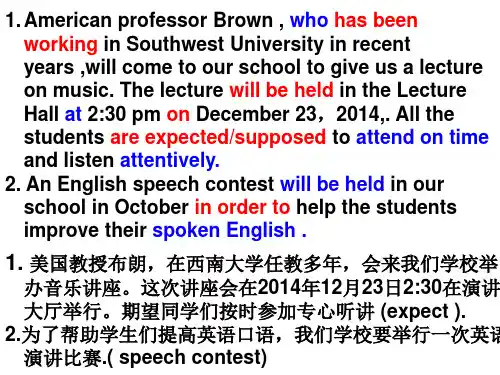
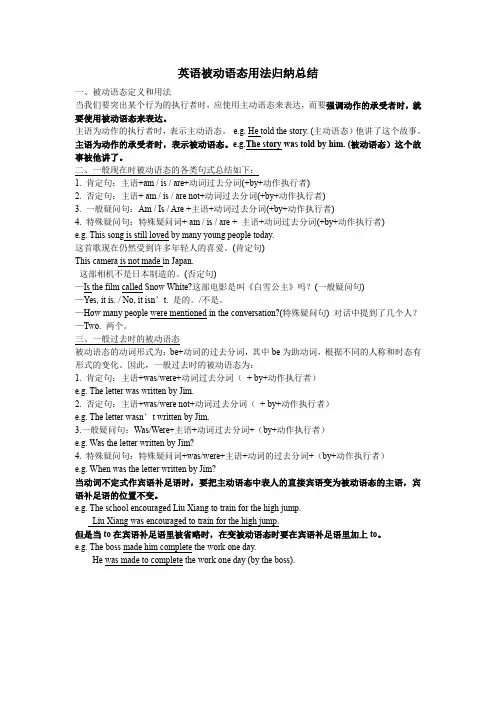
英语被动语态用法归纳总结一、被动语态定义和用法当我们要突出某个行为的执行者时,应使用主动语态来表达,而要强调动作的承受者时,就要使用被动语态来表达。
主语为动作的执行者时,表示主动语态。
e.g. He told the story. (主动语态)他讲了这个故事。
主语为动作的承受者时,表示被动语态。
e.g.The story was told by him. (被动语态)这个故事被他讲了。
二、一般现在时被动语态的各类句式总结如下:1. 肯定句:主语+am / is / are+动词过去分词(+by+动作执行者)2. 否定句:主语+ am / is / are not+动词过去分词(+by+动作执行者)3. 一般疑问句:Am / Is / Are +主语+动词过去分词(+by+动作执行者)4. 特殊疑问句:特殊疑问词+ am / is / are + 主语+动词过去分词(+by+动作执行者)e.g. This song is still loved by many young people today.这首歌现在仍然受到许多年轻人的喜爱。
(肯定句)This camera is not made in Japan.这部相机不是日本制造的。
(否定句)—Is the film called Snow White?这部电影是叫《白雪公主》吗?(一般疑问句)—Yes, it is. / No, it isn’t. 是的。
/不是。
—How many people were mentioned in the conversation?(特殊疑问句) 对话中提到了几个人?—Two. 两个。
三、一般过去时的被动语态被动语态的动词形式为:be+动词的过去分词,其中be为助动词,根据不同的人称和时态有形式的变化。
因此,一般过去时的被动语态为:1. 肯定句:主语+was/were+动词过去分词(+ by+动作执行者)e.g. The letter was written by Jim.2. 否定句:主语+was/were not+动词过去分词(+ by+动作执行者)e.g. The letter wasn’t written by Jim.3.一般疑问句:Was/Were+主语+动词过去分词+(by+动作执行者)e.g. Was the letter written by Jim?4. 特殊疑问句:特殊疑问词+was/were+主语+动词的过去分词+(by+动作执行者)e.g. When was the letter written by Jim?当动词不定式作宾语补足语时,要把主动语态中表人的直接宾语变为被动语态的主语,宾语补足语的位置不变。
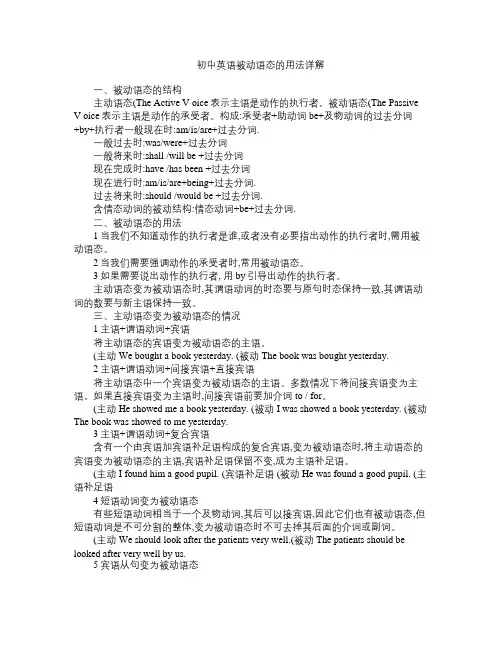
初中英语被动语态的用法详解一、被动语态的结构主动语态(The Active V oice表示主语是动作的执行者。
被动语态(The Passive V oice表示主语是动作的承受者。
构成:承受者+助动词be+及物动词的过去分词+by+执行者一般现在时:am/is/are+过去分词.一般过去时:was/were+过去分词一般将来时:shall /will be +过去分词现在完成时:have /has been +过去分词现在进行时:am/is/are+being+过去分词.过去将来时:should /would be +过去分词.含情态动词的被动结构:情态动词+be+过去分词.二、被动语态的用法1当我们不知道动作的执行者是谁,或者没有必要指出动作的执行者时,需用被动语态。
2当我们需要强调动作的承受者时,常用被动语态。
3如果需要说出动作的执行者, 用by引导出动作的执行者。
主动语态变为被动语态时,其谓语动词的时态要与原句时态保持一致,其谓语动词的数要与新主语保持一致。
三、主动语态变为被动语态的情况1主语+谓语动词+宾语将主动语态的宾语变为被动语态的主语。
(主动We bought a book yesterday. (被动The book was bought yesterday.2主语+谓语动词+间接宾语+直接宾语将主动语态中一个宾语变为被动语态的主语。
多数情况下将间接宾语变为主语。
如果直接宾语变为主语时,间接宾语前要加介词to / for。
(主动He showed me a book yesterday. (被动I was showed a book yesterday. (被动The book was showed to me yesterday.3主语+谓语动词+复合宾语含有一个由宾语加宾语补足语构成的复合宾语,变为被动语态时,将主动语态的宾语变为被动语态的主语,宾语补足语保留不变,成为主语补足语。





从一个例句看定语从句与被动语态的完美结合请大家先看一个句子:We should pay much attention to the good teacher.(我们应该给这个好老师以足够的注意力)这个句子固然不错,但是,若在一篇文章中都是这类平铺直叙的句式结构,就显得单调乏味,令人枯燥了。
我们应当学会一种意思,多种表达,在写作中运用多种句式结构,就会给读者或评分者不一样的感觉。
句式变换的方式多种多样,本文通过例句着重说明如何使定语从句与被动语态达到完美结合。
首先,我们来看看本句变为被动语态的情况:(1)Much attention should be paid to the good teacher(by us).足够的注意力要给予这个好老师。
(2)The good teacher should be paid much attention to(by us).这个好老师应该被给以足够的注意力。
这样就使句子有了主次,有了要重点表达的内容。
例句(1)强调的是much attention,而例句(2)中,则强调的是the good teacher。
其次,我们看看加入定语从句的情况:(3)The attention (that/which) we should pay to the good teacher is much.我们该给这个好老师的注意力是很多的。
(4)The teacher (that/who/whom) we should pay muchattention to is good.我们该给以足够注意力的老师是很好的。
例句(3)中,我们把much attention拆分开来,形成一个主句The attention is much,又通过对attention加上一个定语从句,即(that /which) we should pay to the good teacher,从而达到了对attention的进一步修饰限定。
被动语态一、被动语态概述:语态是动词的一种形式,用以说明主语与谓语动词之间的关系。
英语的语态共有两种:主动语态和被动语态。
主动语态表示主语是动作的执行者,被动语态表示主语是动作的承受者。
被动语态是动词的一种特殊形式,一般说来,只有需要动作对象的及物动词才有被动语态。
汉语往往用"被"、"受"、"给"等词来表示被动意义。
如:He opened the door. 他打开了这扇门。
(主动语态)The door was opened.这扇门被打开了。
(被动语态)二、被动语态的用法:1、不知道或没有必要指出谁是动作的执行者时。
The bridge was builtlast year.这座桥是去年建造的。
He was electe d chairm an.他被选为主席。
2、当更加强调动作的承受者时。
此时动作的执行者由by引导置于谓语动词之后,不需要时可以省略。
The room hasn't been cleane d yet.房间还没有打扫。
The tigerwas killed by him.老虎被他杀死了。
3、当动作的执行者不是人时,多用被动语态。
如:The window was blownby wind.窗户被风吹开了。
The wholevillag e has been washed away by the flood.整个村庄都被洪水冲走了。
4、表示客观的说明常用"It is + 过去分词."句型。
It is said that Lucy has gone abroad.据说露茜已经出国了。
It is believ ed that he is a spy. (=He is believ ed to be a spy.)大家相信他是个间谍。
被动语态一、被动语态概述:语态是动词的一种形式,用以说明主语与谓语动词之间的关系。
英语的语态共有两种:主动语态和被动语态。
主动语态表示主语是动作的执行者,被动语态表示主语是动作的承受者。
被动语态是动词的一种特殊形式,一般说来,只有需要动作对象的及物动词才有被动语态。
汉语往往用"被"、"受"、"给"等词来表示被动意义。
如:He opened the door. 他打开了这扇门。
(主动语态)The door was opened.这扇门被打开了。
(被动语态)二、被动语态的用法:1、不知道或没有必要指出谁是动作的执行者时。
The bridge was built last year.这座桥是去年建造的。
He was elected chairman.他被选为主席。
2、当更加强调动作的承受者时。
此时动作的执行者由by引导置于谓语动词之后,不需要时可以省略。
The room hasn't been cleaned yet.房间还没有打扫。
The tiger was killed by him.老虎被他杀死了。
3、当动作的执行者不是人时,多用被动语态。
如:The window was blown by wind.窗户被风吹开了。
The whole village has been washed away by the flood.整个村庄都被洪水冲走了。
4、表示客观的说明常用"It is + 过去分词."句型。
It is said that Lucy has gone abroad.据说露茜已经出国了。
It is believed that he is a spy. (=He is believed to be a spy.)大家相信他是个间谍。
5、其它常见的"It is + 过去分词+ that"句型还有:It is reported that…据报道It is said that…据说It is believed that…大家相信It is suggested that…有人建议三、主动语态变为被动语态1、主动语态变为被动语态的步骤:(1)将主动句的宾语变为主语:如果主动句的宾语是代词,需将其由宾格变为主格。
第十四周星期一专题复习:被动语态,定语从句一、被动语态。
表示主语是谓语动词的承受者。
结构为be+动词的过去分词(done)by+执行者,这里的be有人称数和时态的变化。
1、各种时态的被动语态。
(1)一般现在时:am/is/are+done(2)一般过去时:uas/were+done(3)将来时:will+be+done(4)现在完成时:has/has been+done(5)含情态动词的被动态:can/may…be+done(6)现在进行时:am/is/are+being+done2、含复合宾语的主动句变为被动句。
(1) tell /ask sb to do sth.→ sb+be asked/ told to do sth感官动词的过去分词(2)(see hear fed watch make let have) sb do st h→sb+be+感官动词使役动词使役动词的过去分词+to do sth例:I heard her sing in the room just now→ She was heard to sing in the room just now练习思考:I watch them playing soccer now(改为被动态)二、定语从句定语从句通常置于它所修饰的名词或代词(先行词)之后,引导定语从句的词(关系代词关系副词)叫引导词。
关键:判断先行词,再确定引导词。
1、关系代词有that(指人或物)which(指物)who(指人)whom(指人)主语宾语Whose(指人或物)2、关系副词有where(地点)when(时间)why原因3、例:It’s mount Tai that lies shangdong province. The girl who we saw yesterday is Mary.It’sa book which introduces China. That’s the girl (whom) I net yesterday Is this the boy whose parents went to Canada Last year? I will never forget the day when we first met This is the school where I study This is the reason why you should leave.4、注意下列几点:(1) Whom which作宾语时介词可放前后。
精心整理被动语态专项练习请写出被动语态的基本结构:________________________________A.一般现在时的被动语态结构:is/am/are+及物动词的过去分词+其它+bysb.1.Football(play)allovertheworld。
2.Manytrees(plant)inNorthChina.3.Rice(grow)inSouthChina.4.Acamera(use)fortakingphotos5.Ioften(ask)todothiswork.()1.Thestrangethingwasused______wine(酒)byancient(古代的)people.A.fordrinkB.todrinkC.drinkingD.drinked()2.Today,toomanytreesarestill_____intheworld.A.cuttingdownB.cutdownC.beingcutdownD.cutteddown()3.English_____inmanycountries,butChinese_____theirownlanguages.A.isspoken,speaksB.speaks,isspokenC.isspoken,speakenD.isspoken,isspoken()4.Thiskindofapple______inJinzhou.A.isgrown B.grow C.grew D.aregrown()5.Theseyoungtreesmust______afterwell.A.look B.looksafter C.belooked D.looked()6.InChinathemoney______tochildrenforgoodluckbytheirparentsorotherseniorinSpringFestivalA.givesB.isgivenC.aregivenD.give()()7.Ourteacherwasseen______totheofficeamomentago.A.go B.togo C.going D.goes ()8.TheOxfordCastle_____byHenry.Itisinverygoodconditionnow.A.builtB.wasbuiltC.hasbeenbuiltD.isbuilt()9.Icecanbe_____water.A.turninto B.turnto C.turnedinto D.turnedto()10.Keysareusedfor_____doors. A.lock B.locked C.locking D.locks()11.Thegreenhouse(温室)shouldbe_____glass.A.madeofB.madefromC.madeintoD.madein()12.Sorry,allthevegetables______.Pleasecometomorrow.A.sellswellB.havesoldoutC.havebeensoldoutD.areselling()13.Themanisbadlyhurt.He_____tothehospital.A.hassentB.hasbeensentC.sentD.hassentfor((7宾语从句I.从下列A、B、C、D中选择一个正确选项填空。
带被动语态和定语从句的句子1. 那些被岁月遗忘的故事,是我心中最珍贵的宝藏。
就像那本被搁置在角落的旧相册,里面的照片虽然有些泛黄,可每一张都承载着一段美好的回忆。
我和奶奶坐在老树下,她指着相册里的照片说:“看呐,这是你爷爷年轻的时候,那时候他可帅啦。
”每一张照片都是一个被时光定格的瞬间,每次翻看,就像重新走进了那些被珍藏的往昔。
2. 你知道吗?被信任的感觉就像沐浴在温暖的阳光里。
我有一个朋友,他就是那种被大家公认的靠谱的人。
他曾经被委托保管一笔钱,那可是一大笔钱啊!在他手里就像被锁进了最安全的保险箱。
他说:“我知道这钱被托付给我,那是大家对我的信任,我可不能辜负。
”这就是信任的力量,被信任的人就像一颗闪耀的星星,照亮周围的一切。
3. 被误解的滋味啊,就像吃了一口酸涩的柠檬。
有一次,我在学校被同学误以为是拿了他的笔。
我当时可委屈了,就像一只被冤枉的小绵羊。
我对他说:“那支笔我都没见过,我怎么会拿呢?”可他不听,还是认定是我拿的。
被误解的时候,心里就像被乌云遮住的天空,阴沉沉的。
直到后来他自己找到了笔,才知道是错怪我了。
哎,被误解可真不好受啊!4. 那座被岁月侵蚀的老房子,是我们童年的乐园。
它就像一位慈祥的老人,见证了我们的成长。
房子里有一个被漆成蓝色的小柜子,那里面藏着我们的小秘密。
我和小伙伴们经常在那座老房子里玩耍,我们会说:“这个被大家忽略的角落,是我们的小天地。
”在那里,每一个被磨损的角落都充满了我们的欢声笑语。
5. 被表扬的时刻总是让人兴奋得像中了彩票一样。
我的弟弟,他是个很努力的孩子。
上次他在学校因为一篇作文被老师表扬了。
那篇作文就像是一颗被精心打磨的宝石,在众多作文里脱颖而出。
老师说:“这篇作文写得非常好,用词准确,情感真挚。
”弟弟回来后,高兴得又蹦又跳,他说:“被老师表扬的感觉太棒了,我以后要写得更好!”被认可真的能给人带来无限的动力啊。
6. 被忽视的人就像角落里的灰尘,不被人在意。
ket 语法总结表摘要:一、引言二、KET语法总结1.名词性从句2.状语从句3.定语从句4.被动语态5.情态动词6.动词时态和语态7.代词8.介词9.连词10.形容词和副词三、结论四、练习建议正文:一、引言作为英语学习者,掌握KET(Key English T est)语法是非常重要的。
KET 语法不仅包括基本的语法规则,如名词性从句、状语从句、定语从句等,还涉及到动词时态和语态、情态动词、代词、介词、连词、形容词和副词等。
在本篇文章中,我们将对这些语法点进行总结,以帮助大家更好地应对KET考试。
二、KET语法总结1.名词性从句名词性从句在句子中起名词的作用,主要包括主语从句、宾语从句、表语从句和同位语从句。
例如:- What he said is true.(他说的是真的。
)2.状语从句状语从句用于修饰动词、形容词、副词或整个句子,主要有时间状语从句、地点状语从句、原因状语从句等。
例如:- I will go to the park because it is sunny.(我将去公园,因为天气晴朗。
)3.定语从句定语从句用于修饰名词或代词,通常由关系代词(如which、that、who)引导。
例如:- The book which is on the table is mine.(桌子上的那本书是我的。
)4.被动语态被动语态表示动作的承受者,主要有一般被动语态、完成被动语态和被动语态的虚拟语气。
例如:- The window was broken by the ball.(窗户被球打破了。
)5.情态动词情态动词表示可能性、推测、建议等,如can、may、must、should 等。
例如:- He can speak French fluently.(他法语说得非常流利。
)6.动词时态和语态动词时态有过去时、现在时、将来时等,语态有主动和被动两种。
例如:- I am eating breakfast.(我正在吃早餐。
专题十八:定语从句一、定语从句:1.定语从句的概念:在复合句中,修饰某一名词或代词的从句叫定语从句。
2.先行词:被定语从句修饰的名词或代词叫先行词。
3.关系词:引导定语从句的连词叫关系词。
如that、which、who、whom、whose、where、when等。
4.由that、which、who、whom、whose引导的定语从句。
关系词指代在定语从句中的作用that既指人也指物作主语、宾语which指物作主语、宾语who指人作主语whom指人作宾语whose既指人也指物作定语二、定语从句:1.先行词是物时,一般情况既可用that,which均可.但下列情况,只用that不用which。
1).当先行词为指物的不定代词,如all、everything、something、anything、nothing、none、the one等时,只能用that。
There is nothing ______ I can do for you .2).先行词被the only, the very, the last, all, no, little等词修饰,只用that。
This is the very book ___ I’m looking for .3).先行词被序数词修饰时,只用that . This is the first nextbook ______ I studied in the middle school .4).先行词为最高级或被最高级修饰时,只能用that。
This is the most beautiful mountain ______ I have ever seen .=I have _____ seen _____ a beautiful mountian .5).先行词既有人也有物时,只能that 。
He told us many interesting things and persons _______ we had .2.先行词是物时,一般情况既可用that也可用which.但下列情况,只能用which不用that。
1).关系代词前有介词时,关系词只能用which 。
This is the building in ______ he lives .2).引导非限定性的定语从句(先行词是物且先行词与关系词用逗号隔开),关系词用which。
His book , ______ was lost last week , has been found now.3.先行词是人时,一般情况下既可用who 也可用that 。
但以下情况下,只能用who。
1).当先行词为those、one、ones、anyone且作主语时,一般用who .Those ____ are singing are all my classmates .2).在there be 句型中,先行词指人时,只能用who。
指物时用that。
There is a girl ______ expects to see you .3).当先行词是I、you、he、they等时,只能用who 。
He ______ plays with fire gets burned .三、定语从句由关系副词when、where、why引导的定语从句。
where = in / at +which when = in / on / at +which why = for + which1.由where引导的定语从句。
1).先行词是表示地点的名词 2).在定语从句中作地点状语Is this the house ____ you lived ?= Is this the house ____ ___ you lived ?= Is this the house ___ you lived in ?2.由when引导的定语从句。
1).先行词是表示时间的名词 2).在定语从句中作时间状语I will never forget the days ______ I met him .= I will never forget the days ____ ____ I met him.注:先行词是the last time 时,when 可省略。
When was the last time you saw the parrot ?3.由why引导的定语从句。
先行词为reason 时,一般用why 。
why在句中作原因状语。
We don’t know the reason ______ they didn’t come .四、注意事项:1.关系词在定语从句中作宾语时,常可省略。
The story _____ he told was very popular .A.who B.whom C.whose D. / 2.that 、who 、which 在定语从句中作主语时,定语从句的谓语动词应与先行词保持一致。
I loves singers who _______(write) their own songs ./She is one of the girls who ______(study) hard .3.定语从句中whose 的确定:无论先行词是人或物,在定语从句中做定语用whose 。
判断:看定语从句的主语前有无限定词(my 、your 、Jim’s 等),若没有,则用whose 。
The girl _____ parents work in Beijing is Kate .A. who B. whose C. which D. that专题十二:被动语态的构成及用法一、被动语态被动语态的基本结构为:be+动词的过去分词各种时态的主动、被动语态的结构如下表(以动词do 为例):时态主动语态被动语态例句主动语态被动语态一般现在时do/does am/is/are+done We clean the classroom..The classroom is cleaned by us .一般过去时did was/were+done He made the kite .The kite was made by him .现在进行时am/is/are+doing am/is/are+being done She is watering flowers .Flower are being watered by her .现在完成时have/has+done have/has+been done Jim has finished the work .The work has been finished by Jim .一般将来时will/shall/be going to+do will/shall/be going to+be done They will plant trees tomorrow .Trees will be planted by them tomorrow .过去进行was/were+doing was/were+being done She was writing a letter this time A letter was being written by her this time时yesterday.yesterday.过去完成时had+done had+been doneJim hadfinished thework.The workhad beenfinished.过去将来时would/should/begoing to+dowould/should/begoing to+be doneHe said hewould makea kite.He said a kitewould bemade byhim.含有情态动词can/may/must+do can/may/must+bedoneI can findhim.He can befound byme.一.被动语态的用法:在被动语态中,主语是动作的承受者,主要用于下列几种情况:(1)不知道动作的执行者是谁。
如:This watch is made in China.更多资料QQ378459309制作:(2)没有必要指出动作的执行者是谁。
如:More trees must be planted every year.。
(3)需要强调或突出动作的承受者时。
如:Chinese is spoken by more and more people in the world.(4)句子的主语是动作的承受者。
如:Many houses were washed away by the food.二、主动语态和被动语态的转换1.主动语态变为被动语态(1)要将主动句里的宾语变为被动句中的主语,若主动句中的宾语是人称代词,要将宾语变成主格。
(2)把主动句中的主语变为被动句中的宾语,主格变成宾格,并用by 引导。
(3)谓语动词变成相应的被动形式。
主动语态:动作执行者+谓语动词主动形式+动作承受者被动语态:动作承受者+谓语动词被动形式+动作执行者如:We asked him to sing an English song.(变为被动语态) →He was asked to sing an English song by us.2.带双宾语的谓语动词变为被动语态谓语动词带双宾语时,既可以将间接宾语转化成主语,也可以将直接宾语转化为主语。
若将间接宾语转化为主语,则保留直接宾语;若将直接宾语转化为主语则保留间接宾语,且在被保留的间接宾语前加上介词to 或for。
如:She gave me a book.(变为被动语态) →I was given a book by her.(间接宾语me改为了主语)A book was given to me by her.(直接宾语a book 改为了主语)3.动词短语变为被动语态许多由动词和介词、副词构成的动词短语相当于及物动词,可以有宾语,也可以有被动语态。
在变为被动语态时,不可丢掉构成动词短语的介词或副词。
如:We should speak to old men politely.(变为被动语态)Old men should be spoken to politely.(to不可省略)4.带复合宾语的动词变为被动语态宾语加上宾语补足语一起构成复合宾语。
变被动语态时,只把宾语变为被动句的主语,宾语补足语保留在原处,成为主语补足语。
如:I heard Jane playing the piano in her room.(变为被动语态) →Jane was heard playing the piano in her room.5.变被动语态后动词形式的选择主动句中在感官动词see,hear,watch,feel,notice等,及使役动词let,make,have等后跟省略to的不定式,变为被动句时,应加上不定式符号to。